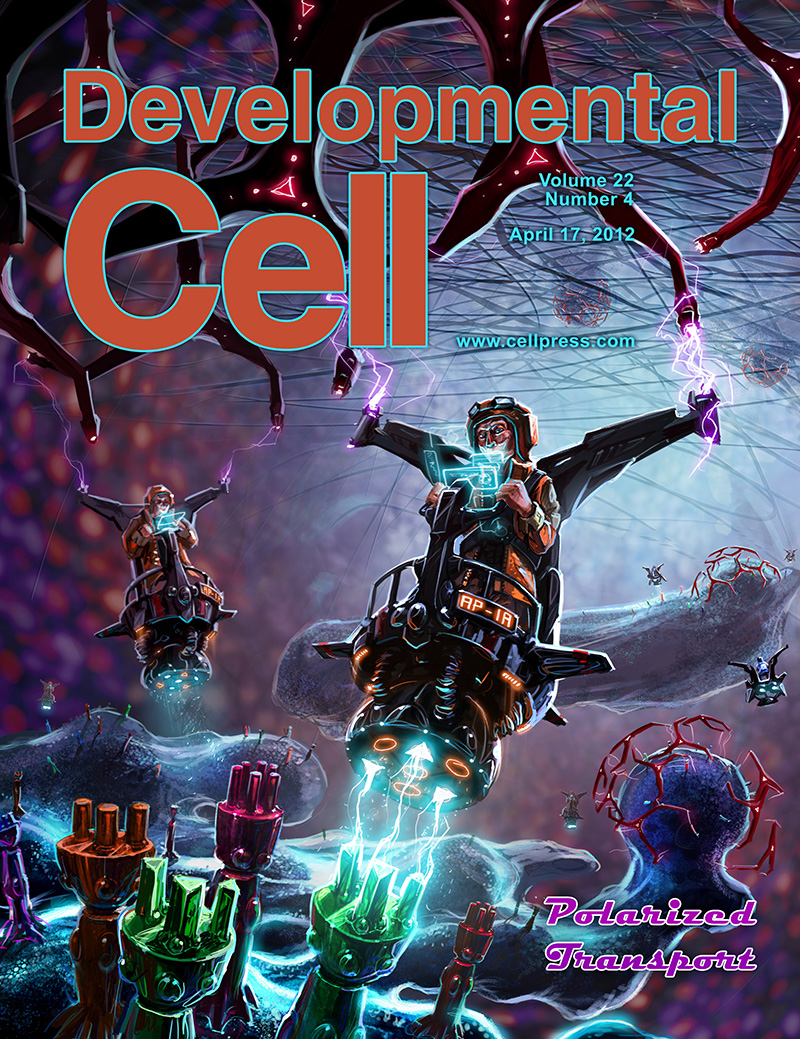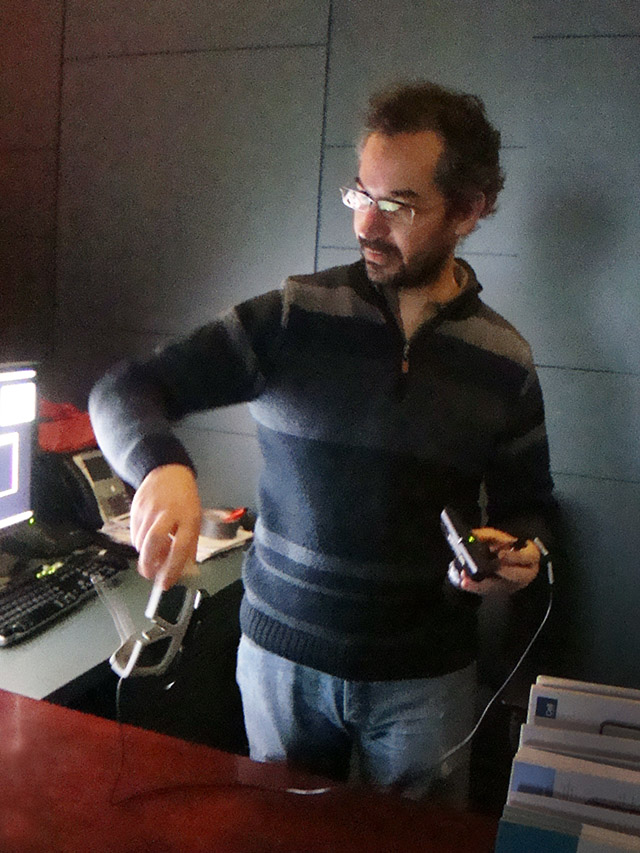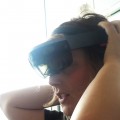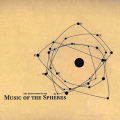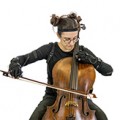Pratt DAHRC collaborates with Weill-Cornell Medical College for interdisciplinary research, education, and technology development. Some results of the effort which are ready for release are mentioned here.
Science Visualization
Developmental Cell Cover Illustration
Pratt researchers HyukJae Henry Yoo and Tianxu Tim Guo created a scientific illustration to augment the publication of a science journal by Weill-Cornell cell biology researchers. As a newcomer to the scientific community, the resulting output illustration received the honor of being selected as the cover of the Dev Cell publication’s April 2012 issue (move the slider bar issue to the right, to the April issue). The readership and recognition level of the Dev Cell publication within the biological science community is said to be comparable to the Time Magazine for the general public.
The scientific journal which were published, titled, “The Clathrin Adaptor AP-1A Mediates Basolateral Polarity” by Diego Gravotta, Jose Maria Carvajal-Gonzalez, Rafael Mattera, Sylvie Deborde1, Jason R. Banfelder, Juan S. Bonifacino, and Enrique Rodriguez-Boulan is available here, with the short summary below.
_____________from Dev Cell, April 2012_______________
Dev Cell Journal Summary
Clathrin and the epithelial-specific clathrin adaptor AP-1B mediate basolateral trafficking in epithelia. However, several epithelia lack AP-1B, and mice knocked out for AP-1B are viable, suggesting the existence of additional mechanisms that control basolateral polarity. Here, we demonstrate a distinct role of the ubiquitous clathrin adaptor AP-1A in basolateral protein sorting. Knockdown of AP-1A causes missorting of basolateral proteins in MDCK cells, but only after knockdown of AP-1B, suggesting that AP-1B can compensate for lack of AP-1A. AP-1A localizes predominantly to the TGN, and its knockdown promotes spillover of basolateral proteins into common recycling endosomes, the site of function of AP-1B, suggesting complementary roles of both adaptors in basolateral sorting. Yeast two-hybrid assays detect interactions between the basolateral signal of transferrin receptor and the medium subunits of both AP-1A and AP-1B. The basolateral sorting function of AP-1A reported here establishes AP-1 as a major regulator of epithelial polarity.
_________________________________________________
What Pratt DAHRC researchers had to do:
- Read the paper
- Extract and understand the journal’s scientific significance
- Collaborate with the Weill-Cornell researchers via interview sessions and emails, trying to obtain answers to the missing portions of the understanding
- Distill the essence of the journal, and express the story in the format of a single illustration
Teaching Life Scientists to Visualize: Biovisualization Initiative
The basic premise of the Biovisualization initiative is to enable the life scientists and medical researchers to see better of what they are working on, utilizing the visualization methods and tools of artists and designers. It was made possible by the Department of Ophthalmology and CTSC(Clinical and Translational Science Center) of Weill-Cornell Medical College. The work-in-progress website at CTSC Cornell-Weill Medical College is here.
After validating through the science concept illustration project that artists and designers have something to contribute to the field of science, the Pratt-Cornell collaboration developed into an initiative named Biovisualization, which includes a series of courses to train scientists to learn how to visualize their ideas, hypotheses, methods, processes, and overall thinking, through visual communication: storytelling, sketching, illustration, and presentation.
The first Biovisualiztion I course ran in the Fall semester of 2012. The group of students, researchers, and clinicians who are M.D., PhD,. Post-Docs, came to take the course to learn for the first time how to sketch with pencils as well as learn to use the digital software tools to visualize ideas and stories with Photoshop, Maya, and other medical software to convert MRI and CT Scan data as well protein molecule simulation data to 3D digital models which can be manipulated in Maya software.
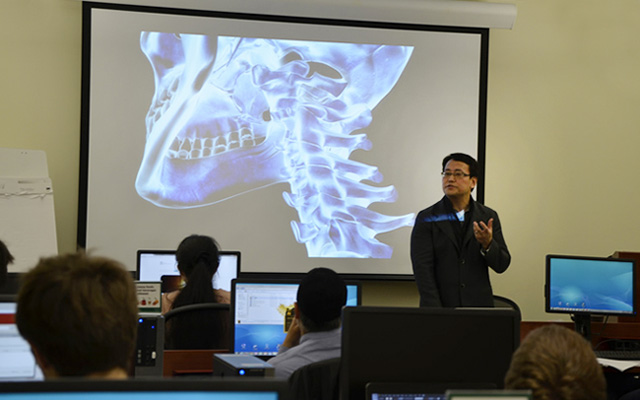
Pratt DAHRC Director HyukJae Henry Yoo teaching the BioVisualization course at Weill-Cornell Medical College.
Some of the resulting student work can be seen here. The course is listed under Cornell’s Data Analysis & Visualization on the WCMC Medical Library Training page.
CAVE Virtual Reality Environment
Cornell boasts the ultimate CAVE virtual Environment system.
In 2011 and 2012, Pratt researchers and Cornell scientists get together to discuss interface design and content development for the CAVE Virtual Environment.
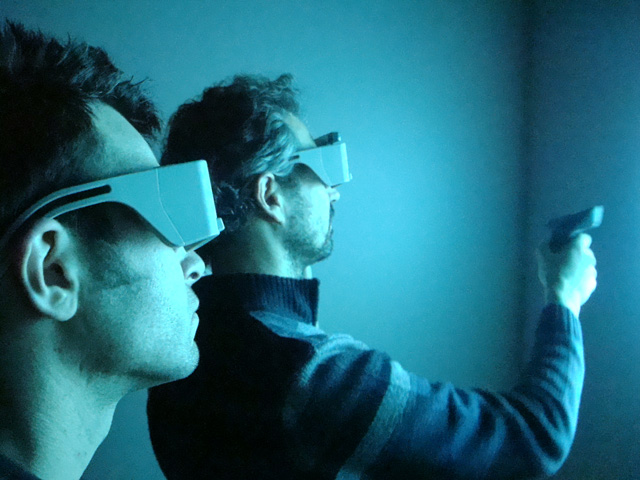
Cornell Researcher Luis Gracia driving the CAVE and Pratt DAHRC researcher Francis Bitonti observing
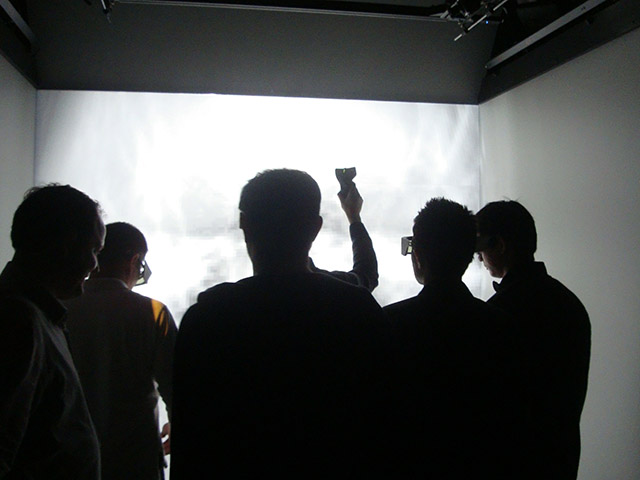
Prepare to take off…
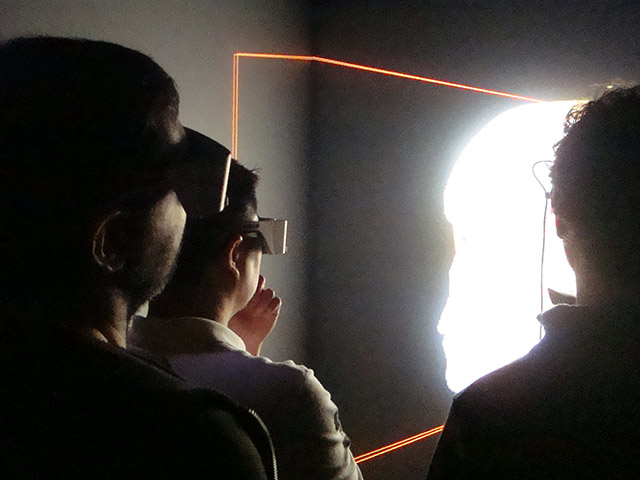
Immersed in the CAVE
Videos which show the CAVE in operation. NOTE: As the CAVE is an immersive stereo 3-D simulation, the video’s blurry image is due to both the right-eye and left-eye imagery being shown together. If possible, try viewing the videos using 3-D glasses.
Research Project: 4D Eye – Interactive Sicence Visualizer
What do you get when you combine Google Maps, Powers of Ten, and Wikipedia together? Answer: 4dPerson. 4dPerson is an interactive visualization tool in development which lets the viewer learn about the human body in dynamic manner appropriate to this millenium. 4dEye is the first portion of the 4dPerson research initiative, which has been developed in collaboration with the Department of Ophthalmology at Weill-Cornell Medical College.
DAHRC Researchers HyukJae Henry Yoo, Liubo Borissov, Junhwans Sung, Arnold Chu, Francis Bitonti, and Tianxu Tim Guo were teamed with WCMC researchers Enrique Rodriquez-Boulan, Ryan Schreiner, and John Victor to research on the human eye.
Reseracher Junghwan sung has produced prototypes of the intial development of the interactive eye. The online version will be soon deployed, to be shown at the 4dPerson site.

